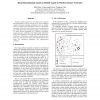Free Online Productivity Tools
i2Speak
i2Symbol
i2OCR
iTex2Img
iWeb2Print
iWeb2Shot
i2Type
iPdf2Split
iPdf2Merge
i2Bopomofo
i2Arabic
i2Style
i2Image
i2PDF
iLatex2Rtf
Sci2ools
LCN
2005
IEEE
2005
IEEE
Data Dissemination based on Mobile Agent in Wireless Sensor Networks
Recently, mobile agents have been proposed for efficient data dissemination in sensor networks [1-6]. In the traditional client/server-based computing architecture, data at multiple sources is transferred to a destination; whereas, a task-specific executable code traverses the relevant sources to gather data in the mobile-agent based computing paradigm. As described in [1], many inherent advantages (e.g. scalability, extensibility, energy awareness, reliability) of the mobile agent architecture make it more suitable for sensor networks than the client/server architecture. In this paper, a mobile agent is exploited in three levels (e.g. node level, task level, and combined task level) to reduce the information redundancy and communication overhead.
| Added | 25 Jun 2010 |
| Updated | 25 Jun 2010 |
| Type | Conference |
| Year | 2005 |
| Where | LCN |
| Authors | Min Chen, Taekyoung Kwon, Yanghee Choi |
Comments (0)

